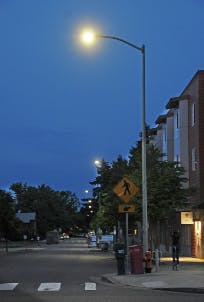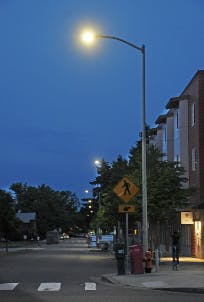Northwestern US city works through technical and utility roadblocks to complete a major SSL street light project that delivers as much as 75% in energy savings.
The US Department of Energy (DOE) has published another report in its Gateway series of research projects that study the deployment of LED lighting in a variety of applications. The latest study focused on the US city of Portland, OR details both the technical challenges of a large solid-state lighting (SSL) conversion of street lights and the logistical obstacles of a city working with a utility to establish a new electrical rate structure that can help justify the high upfront cost of LED fixtures. The DOE's Pacific Northwest National Laboratory (PNNL) and Municipal Solid State Lighting Consortium (MSSLC) were responsible for the report, "Investing in their future: Portland's purchase and conversion of an LED street lighting system."
Interested in more articles & announcements on LED lighting?
The Portland Bureau of Transportation (PBOT) began serious consideration of a large-scale LED retrofit project back in 2010, but the work progressed slowly in part due to a complicated relationship with utility Portland General Electric (PGE). The utility owned many of the more than 55,000 street lights installed in the city and also serviced some poles owned by the city. At the time PGE had no discounted tariff for LED lights and therefore the potential for the city to capitalize on energy savings was missing.
Ultimately PBOT moved to purchase the entire street light inventory from PGE, and the Oregon Public Utilities Commission (OPUC) worked with the two to add an LED tariff. But that process was lengthy and included a detailed study of a number of options.
Meanwhile, the PBOT had trialed LED street light systems in limited locations and was an early member of the MSSLC. And the city had joined with other smaller cities in Oregon to present a unified front to OPUC and lighting manufacturers.
The city took a unique approach to the concept of dimming. PBOT did not want to pay for a networked system with remote control, but wanted to ensure that the light levels could be adjusted if needed. So the luminaire suppliers had to deliver a driver that could be set manually to three different levels.
The adaptability has paid off already. The report notes that response from the citizens to the new lights has been largely positive, but some complained about light levels being too high. In residential areas, the luminaires installed can deliver 3000 lm at 29W, 4100 lm at 42W, or 5000 lm at 54W. PBOT is setting all of those luminaires to the lowest level, resulting in 75% energy savings relative to the prior 118W high-pressure sodium (HPS) lighting.
The city also included a unique clause in the solicitation to contractors noting that LED street light prices were to be renegotiated each year — counting on prices to fall. And indeed prices have dropped. The city paid $155 for the residential-area fixtures in the second half of 2014 and that figure has dropped to $124 this year. The report also documents the installation cost at about $75 each, not including traffic control.
Thus far Portland is about halfway through the LED street light retrofit project. On collector and arterial roads that once included 150W to 400W HPS lighting, 63W to 180W SSL products are being installed. The city reports that while the project ended up being far more complicated than it expected, the results justify the effort.
The DOE has published several other Gateway reports on outdoor lighting projects. Post-top LED luminaires were the focus of an early report on a Central Park project in New York City. Another report covered a parking lot project at a Walmart in Leavenworth, KS. You can read the entire Portland Gateway report on the DOE SSL website.






